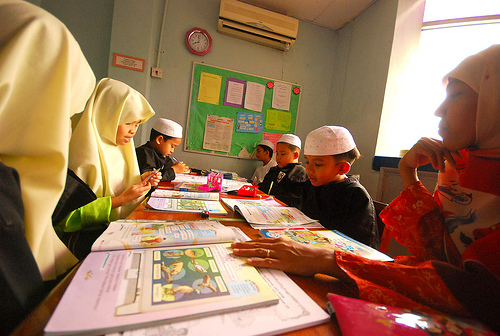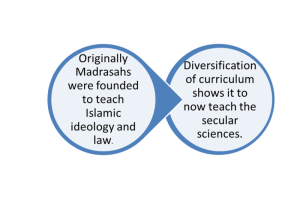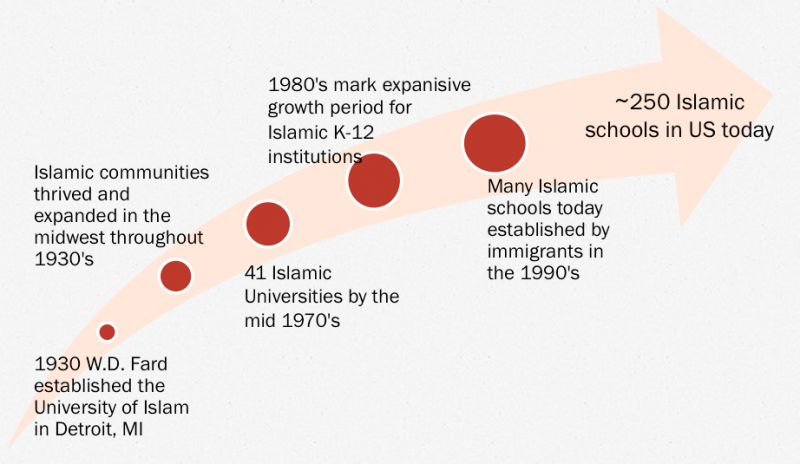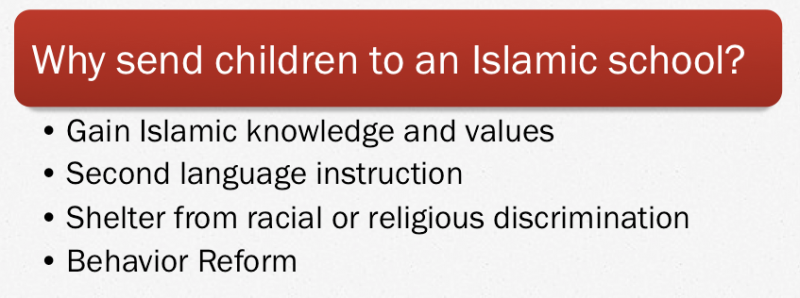Islam and Education

Students of Madarasa Bhalwal
by Rizwan Sagar , used under 
Happy Ramadan
by Mohammad KhedMati , used under 
Alison Hamrick, Molly Steinkamp, and Nicole Zimmerman
Islamic education can mean one of four things : education for Muslims about their faith (more commonly referred to as Islamic Studies), education for Muslims in general, education about Islam for non-Muslims, and education in the spirit and philosophy of Islam. We chose to focus on education for Muslims in general, focusing on religious and secular disciplines. In this manner, “Islamic education can be defined as the harmonious actualization and nurturing of human’s physical, intellectual, social, emotional, ethical, and religious aptitudes to cause his or her nearness to God” (Alavi, 2013). In other words, Islamic education means to better oneself in every aspect of life to become closer to God. Every action that a person makes in the direction of becoming closer to God is considered as worship and therefore, educational.
Islamic Education in the Middle East
In the Islamic countries throughout the middle east, Madrasahs are known as the Islamic teaching schools. Some of the countries’ Madrasahs are run differently.
Indonesia:
Parents send their children to private Islamic schools because of the nationalist emphasis in public schools. Children at the schools are looking to gain an understanding of Arabic language, The Sharia, and Muslim traditions and history. They also gain knowledge in more modern subjects such as geography, science, and math. Students at the schools are taught to think for themselves and are guided in making their own interpretations.(Frederick & Worden, 2011)

Safinatun Najah School Photoshoot – In the class
by Amrufm , used under 
Children of different ages are taught differently in Madrasahs. The curriculum in India is the Dars-i-Nizami. Under the Dars-i-Nizami,children ages 6-14 are taught primary education at Madrasahs. In the Madrashas they are taught subjects like The Koran, Islamic ethics, literature, language, and manual trades during this period. After age 14, students can choose to study practical lessons that they have an interest in regardless of their social class. There is also flexibility in terms of finishing secondary school. Graduates from the Madrasahs are finding the discipline of madrasah training helps to focus on further studies better than their peers. Even though Madrasah learning is narrower than that of other schools in India, the students there are taught to think deeper. This thinking brings on a different kind of thinking and learning. (Evans, 2006) The most popular Islamic schools in India is the Darul Uloom Deoband. According to the school’s website, “The Darlum Uloom Deoband has been considered an incomparable teaching institution for the religious education of the Muslims not only in the sub-continent but also throughout the Islamic world.” (Darul Uloom Deoband)
Islamic Education in the West
History of Islamic Education in the U.S.
The first Islamic educational institution established in the United States was The Nation of Islam, founded by W.D. Fard in Detroit, MI in 1930. It was originally geared for adults and children alike, although the institutions for children quickly became the most popular. Fard also established a school in the same area and named it The University of Islam. The schools were still for children grades kindergarten through twelfth, but they were called “universities” to imply that the curriculum was much more rigorous and advanced than the rapidly declining public school systems at the time. Communities united by the NOI continued to grow throughout the Midwest andcome mid-seventies, forty-one University of Islam schools were established in the United States. This history, however, makes up a small percentage of Islamic schools currently in the United States. Recent immigrants, mainly from South Asian and the Middle East, established roughly 85% of today’s Islamic educational institutions (Grewal, 2013).
(Grewal, 2013)
Curriculum:
Many would be surprised to discover that many of the K-12 private Islamic schools in the United States are increasingly being molded after the American public school system as well as faith-based private schools. They provide Advanced Placement courses, dual credit from neighboring universities, and many even use the same textbooks. Since these institutions are faith based, students are expected to take additional Islamic focused studies and Arabic courses (Grewal, 2013).
This is the general curriculum for The Islamic School of Indianapolis:
(Islamic School of Indianapolis, 2009)
Most Islamic schools are also participting in western standardized testing participate in standardized testing, and many are also increasing their extra curricular activities. Sister Clara Muhammad schools offer opportunities such as athletics, step dance, and debate teams (Grewal, 2013), while The Islamic School of Indianapolis offers wide extra curricular for all ages K-12 ranging from math bowl to an equestrian club (Islamic School of Indianapolis, 2009).
Why send Children to an Islamic School?
It is a common misconception that only Muslim children can attend Islamic schools (MTI). In truth, only about 4% of Muslim families send their children to these institutions. So why do some individuals choose these schools for their children (Grewal, 2013)?
Islamic education in the United States is structured almost identically to other faith based Western private schools. It is much easier to relate to and understand than one would think. Although many children are at these schools for a variety of different reasons, they all have one common goal: To receive a good education to create a bright future for themselves and for their country.
References
Alavi, H. R. (2013, April). Islamic Educational Goals, Methods, and Content, with Emphasis on Shia’ Faith . Journal of Research on Christian Education , 4-20 .
(n.d.). Retrieved from Darul Uloom Deoband: http://www.darululoom-deoband.com/english/index.php?main=regulations/index.htm
Evans, A. (2006). Understandning Madrasahs. Foreign Affairs.
“Extra-curricular Activities – Islamic School of Indianapolis.” Islamic School of Indianapolis. N.p., 2009. Web. 03 Dec. 2013. http://www.isimti.org/extra-curricular-activities.html
Frederick, W., & Worden, R. (2011). Indonesia a country study. Federal Research Division Library of Congress.
Grewal, Zareena A., and R. David Coolidge. “Islamic Education in the United States”, The Cambridge Companion to American Islam. 1st ed. Cambridge: 2013. 246-265. Cambridge Companions Online. Web. 03 December 2013.http://dx.doi.org/10.1017/CCO9781139026161.017
Jamjoom, M. I. (2010). Female Islamic Studies teachers in Saudi Arabia: A phenomenolgoical study . Teaching and Teacher Education , 547-558 .






